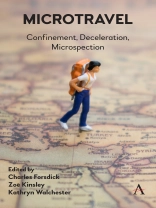The 2020 COVID-19 pandemic imposed immobility on large sectors of the world’s population, with confinement becoming for several years an everyday reality. The lives of those who previously enjoyed the privileges of being ‘fast castes’ ground to a halt, while at the same time the displacement of more vulnerable populations along well-established migration corridors has been radically reduced. The result has been a recalibration of the scale of journeying, with travellers slowing down and readjusting their relationship to the proximate and nearby. This situation has provided an opportunity for those who study travel and travel writing to rethink their object of study. This volume explores and historicizes the phenomenon of ‘microtravel’, designating slower journeys within a limited radius which allow, and sometimes necessitate, new forms of experiencing the world.
The contributors reveal how these practices are far from new and are indeed evident across numerous examples of journey narratives from earlier periods. The volume considers a diverse range of forms, including fictional texts. It also includes ficto-critical writing, allowing a fuller exploration of new approaches to microtravel in the twenty-first century. Sometimes deceleration is reduced to immobility, with the traditional horizontal axis of travel replaced by a burrowing down into time, place and space. Contributions engage with the following four intersecting themes:
Confinement and immobility: travel writing is traditionally associated with tropes of expansiveness and openness. The volume disrupts this understanding by claiming that the travelogue is often more accurately understood as a form dependent on tensions between mobility and immobility, between confinement and liberty. Confined travellers may experience a breakdown of the journey as their progress stalls and they are reduced to a state of sessility. This physical restriction can lead, however, to different modes of travelling, an understanding of microtravel associated with slowing down and perceiving the place differently. For some, this sessility is a choice, a restricted frame of reference or scope imposed on their travels. Deceleration and pedestrianism: confinement leads to an inevitable slowing down of the journey, but microtravel encompasses other forms of spatial limitation. Eschewing mechanized transport, for instance, the pedestrian becomes reliant on self-propulsion, reducing the dimensions of the world to those of the travelling self. Walking exemplifies the impact of deceleration on the journey, activating multisensory forms of engagement and ensuring direct, close contact with the field of travel. The return of walking in contemporary travelogues may demonstrate, however, a nostalgia for earlier modes of journeying, and there is a need to recognize the pitfalls of such romanticization. Palimpsestic travel: Kris Lackey coined the term ‘vertical travel’ to describe journeys that disrupt the traditional horizontal axes of travel. Robert Macfarlane has written, in Underground, about itineraries that burrow beneath our feet and explore the hidden and the unseen. This volume focuses also on the notion of palimpsestic journeying as a form of microtravel, an engagement with place that reveals historical layers and allows the travellers to create connections between the past and present. Microspection and microsound: just as deceleration can trigger heightened sensory awareness of the multiple textures of place, on occasion moving beyond the human emphases of the Anthropocene, so our understanding of microtravel is associated with an attention to detail otherwise missed from mechanized journeys or those reliant on acceleration of the body through space.
Daftar Isi
Notes on Contributors; Microtravel: An Introduction ; Charles Forsdick, Zoë Kinsley and Kathryn Walchester; Section 1. Confinement and Immobility; How to Travel in Monastic Confinement: An Imaginary Journey to the New World; Joëlle Weis; The Nile, Immortality and the Body in Lucy Duff Gordon’s Letters from Egypt; Sally Abed; A Slow Boat to Indochina: Immobility and Micro-movements on the Road to Indochina; Gábor Gelléri; No Going Back: Interrupted Journeys and Identity Crisis in Marie Ndiaye ; Carole Delaitre; Section 2. Deceleration and Pedestrianism; Friedrich Engels Travels in a Chimney; Jayson Althofer; ‘I Wanted to Think, Write, Stay or Move on at My Own Speed and Unencumbered’: Pedestrian Rites of Passage in Patrick Leigh Fermor’s A Time of Gifts; Béatrice Blanchet; ‘Foot foundered and broken down’: Painful Pedestrianism in John Clare’s ‘Journey out of Essex’ ; Zoë Kinsley; Section 3. Palimpsestic Travel; Elegy for the Living: Travels in Guyana with Michael Swan and Wilson Harris; Patricia Murray; Back to Base: Palimpsest Travel in the Black Country Geopark; R. M. Francis; Observed and Reflected: Women Tourists, Microtravel and Souvenirs, 1750–1830 ; Emma Gleadhill; Section 4. Microspection and Microsound; ‘This Is a Place Where We Should Like to Have Lived’: The Garden As ‘Dwelling Place’ in Dorothy Wordsworth’s Travel Writing; Kathryn Walchester; In a Sound World: On Microaudition As a Mode of Microtravel; Charles Forsdick; ‘The echo of great spaces traversed’: Microaudition and Vertical Travel in In Search of Lost Time; Eleanor Lischka; Index
Tentang Penulis
Charles Forsdick is James Barrow Professor of French at the University of Liverpool; Zoë Kinsley is Associate Professor of English Literature at Liverpool Hope University; Kathryn Walchester is Reader and Subject Leader for English at Liverpool John Moores University.












